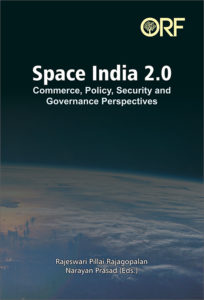One of the more memorable events from Manchester over the last week. A poem by Tony Walsh. I don’t listen to much poetry but this is a Riveting five minutes.
Book Review : Space India 2.0
Publisher: Observer Research Foundation
Author: Edited by Rajeswari Pillai Rajagopalan and Narayan Prasad
Free download from http://www.orfonline.org/research/space-india-2-0-commerce-policy-security-and-governance-perspectives/
If you are looking for a single source of current state of play with the Indian space programme from a diverse collection of writers from in and outside India – this is it.
This book is a collection of 26 chapters written by authors with expertise and first-hand experience covering a broad range of topics. The book is divided into to five themes on Space Commerce, Policy, Security, International collaboration and concludes with Sustainability & Governance. The authors include former ISRO director, academics, scientists, researchers, legal experts and some from the growing community of space start-ups.
Authors come from USA, Australia, Japan, France and Russia give a unique international perspective on the policy and evolution of the space activities in India. Each chapter is written as a standalone piece and whilst there is some repetition the varied writing styles is quite refreshing. Between them the contributors discuss the increasing commercialisation of ISRO’s operations, the growth of space start-ups, India’s new ground-based assets to aid space debris monitoring, opportunities for India-Australia collaboration, the remarkable growth of internet users in India and increasing reliance on digital services for the benefits of all of India’s 1.2 billion population.
The space security section deals with some of the most fraught and testing topics that rely on space assets. In his chapter, Ajey Lile describes India’s conventional military assets with a surprising degree of quantitative data. For example, the Indian army has 1,300,000 active personnel, 6,464 tanks and 290 self-propelled guns. This level of detail a decade ago would probably have been seen as a security breach. As a retired wing commander, Lile is likely to have the authoritative sources for this data and clearance to put this information in the public domain. Lile highlights a mismatch between India’s space strategy, its current space assets and the political indecision on how space should be used for national defence. Similarly, in her paper, Rajeswari Pillai Rajagopalan addresses the changing geopolitical landscape around the potential military use of space. She points to the absence of political and financial commitment from the Indian government which does not bode well for India’s national security in the long-term.
Kumar Abhijeet emphasises India’s need for domestic space legislation to support not only the emerging private space sector but India’s obligation to international treaties such as the Outer Space treaty. In the 1960s there were just two countries with space programs, now there are around 60. International collaboration will be key to ensuring that space around the Earth used by communication, navigation and meteorological satellites is kept free of hostile activities that have marred human history on Earth. In its own way, this compilation from international authors is an example of the collaboration essential for humanity’s eventual use and exploration of space.
This book is an interesting up to date resource with an international perspective. If you want to know all about the Indian space program, this book along with the following four will offer a pretty good wholesome picture
- ISRO: A Personal History by R. Aravamudan
- From Fishing Hamlet to Red Planet: India’s Space Journey. Ed. P.V. Manoranjan Rao
- Reach for the Stars: The Evolution of India’s Rocket Programme. By Gopal Raj (an incredibly rich source of information about ISRO and a book with a much lower profile than it deserves)
- Touching Lives: The Little Known Triumphs Of The Indian Space Programme. By S.K. Das
The best part was a bunch of new writers that I had not come across before. I expect to read more of their work in the future. I will conclude with my usual whing regarding the absence of a back-of-the-book index and a few typos that should have been picked up during proofreading.
Public Event. Anglo Indian Stephen Smith – India’s forgotten Rocketeer
What: A public talk o n Anglo Indian Stephen Smith. His life and achievements.
n Anglo Indian Stephen Smith. His life and achievements.
Where: The Larkhill Centre, Thorley Lane, Timperley, WA15 7AZ (about 3 miles from Manchester International Airport)
When: 19:30 – 20:15 Tuesday 21st March 2017
The event is organised by the India Study Circle for Philately. During the 1920s Stephen Smith founded the Calcutta Philatelic Club and the Aero Philatelic Club of India (which changed its name to the Indian Airmail Society in 1930). The rocket mail covers flown in his rockets were in demand by collectors then and remain so today. A bit more about him on this piece I wrote here and checkout the update in my comment to the same post.
In the talk I will speak about his personal life story and provided an update on having recently made contact with his family (grand-daughter and great grand-daughter) living in London. The event is open to the public and is free – includes tea and biscuits.
ISRO’s Chandrayaan-1 – detected in lunar orbit
Using an innovative radar technique, NASA has been able to detect two spacecraft in lunar orbit from the surface of the Earth. NASA’s Lunar Reconnaissance Orbiter was launched in 2009 and was in lunar orbit at the same time as Chandrayaan-1. Although a joint experiment was designed for both spacecraft, it did not work out. LRO is still operating in Lunar Orbit today. Communication with India’s Chandrayaan-1 was lost in August 2009. At the time ISRO engineers estimated that Chandrayaan-1’s orbit would decay and it would impact on the surface of the Moon by around 2012. The new microwave radar technique using three of the world’s largest radio telescopes (Goldstone, Arecibo and Green Bank) first located the Chandrayaan-1 in July 2016. Remarkably it was still pretty much in its 200km polar orbit going round the Moon every 2 hours.

Chandrayaan-1 was originally (November 2008) in a 100km orbit which was raised to 200 km (May 2009) to overcome internal heating problems. Although not welcomed at the time because the resolution of the data captured by several of the onboard instruments was reduced given the higher altitude. This raised orbit is probably the reason it survives in lunar orbit today.
One of the better write-ups, from 2009 about the demise of the Chandrayaan-1 mission from an accomplished Indian journalist T.S. Subramanian here.
